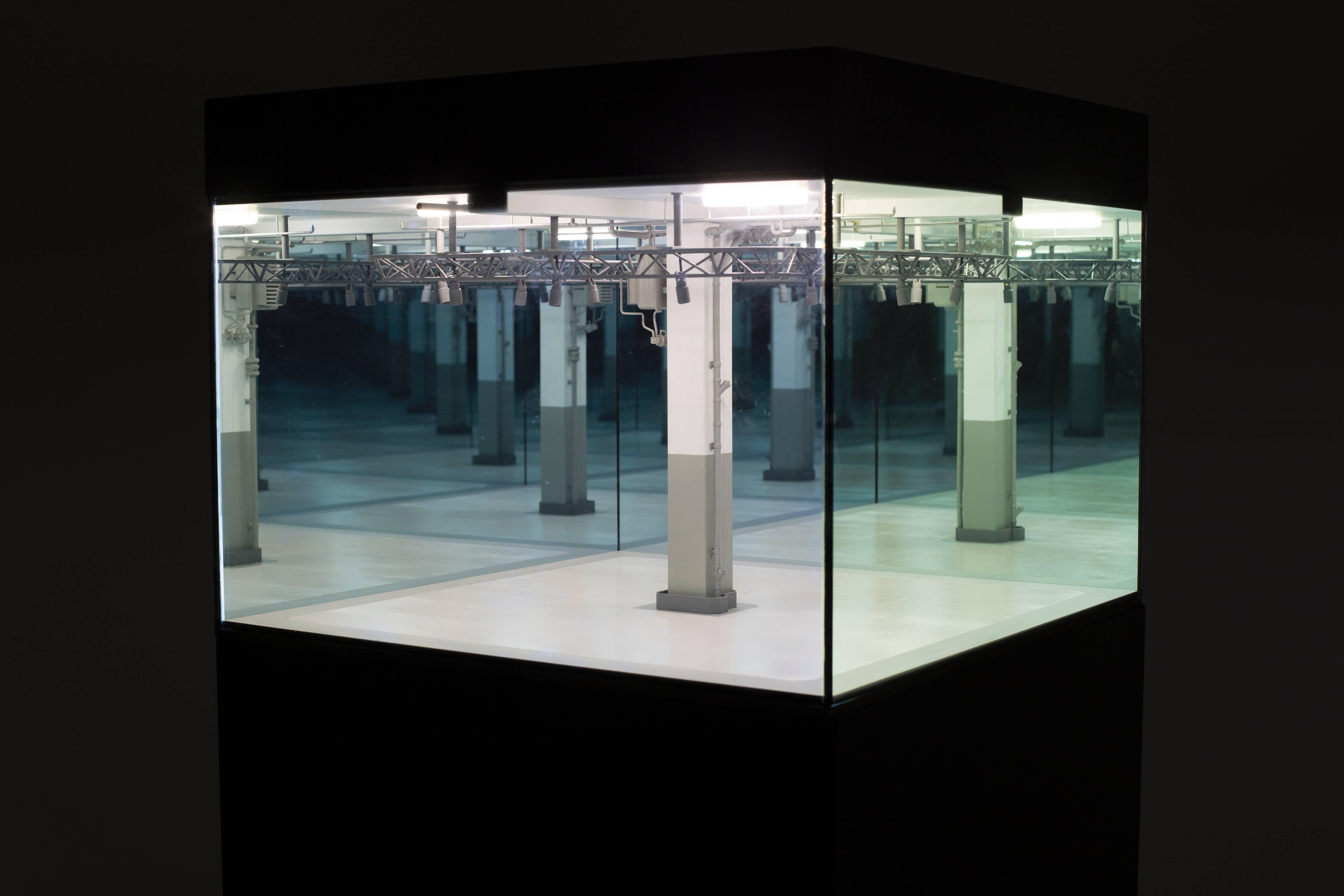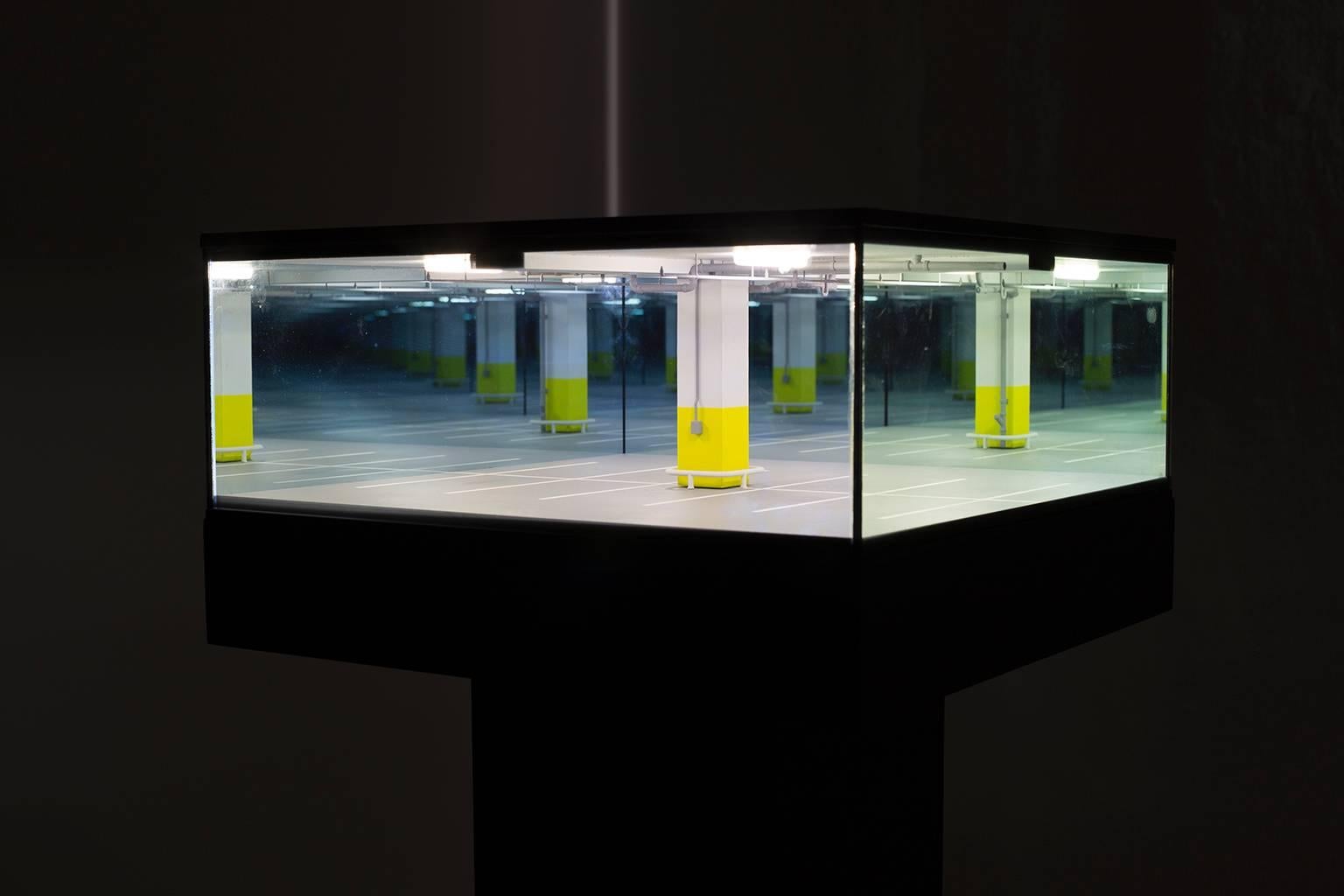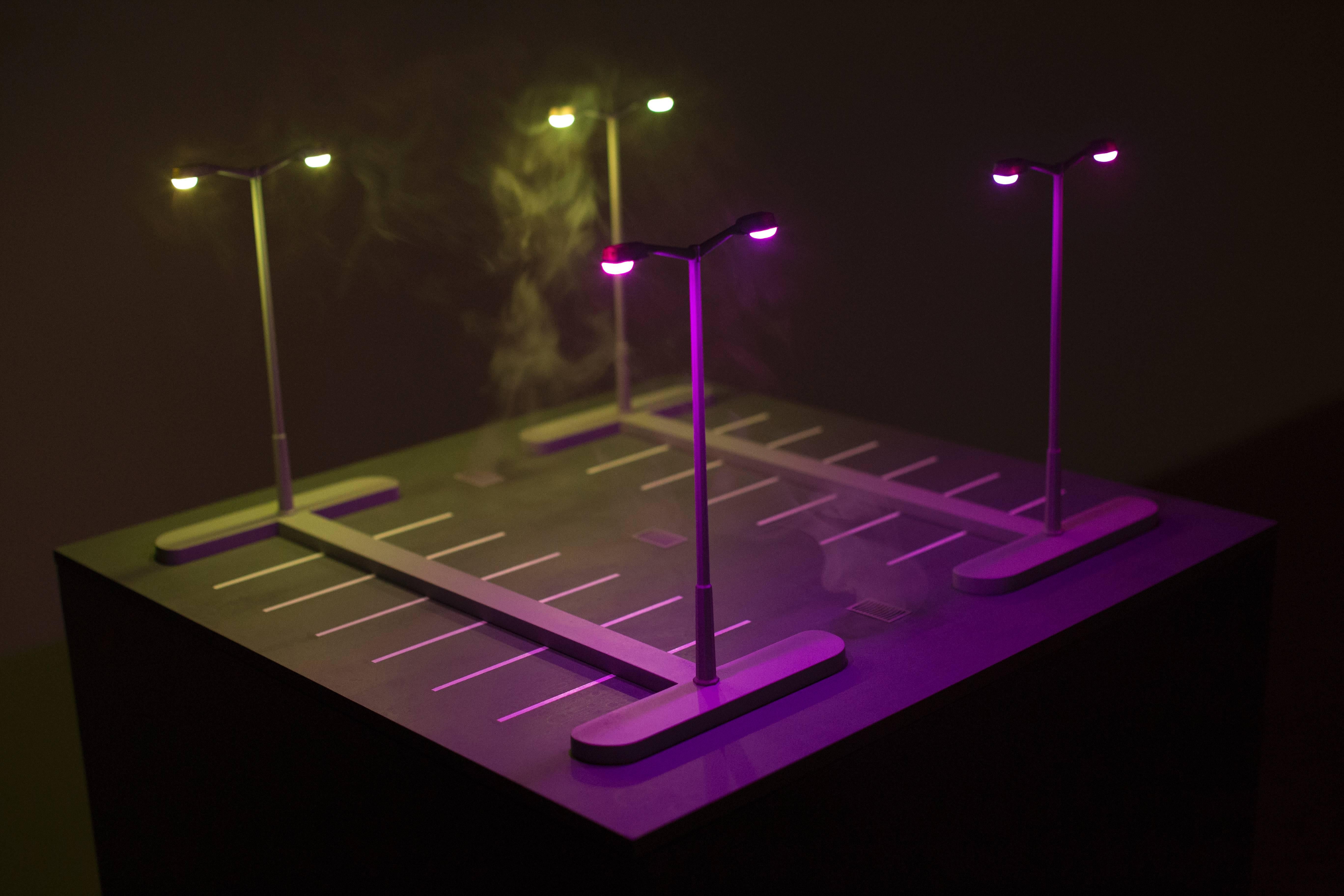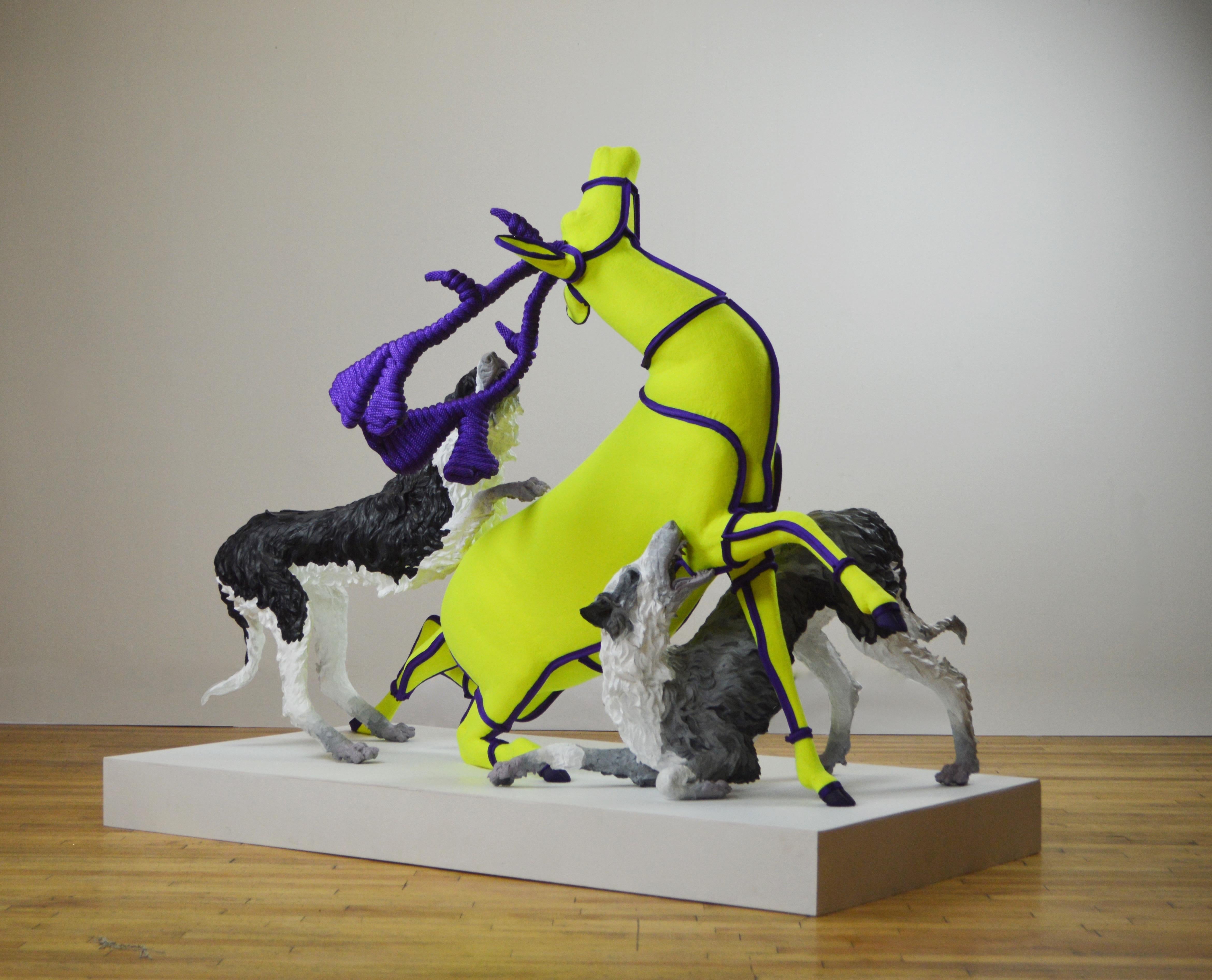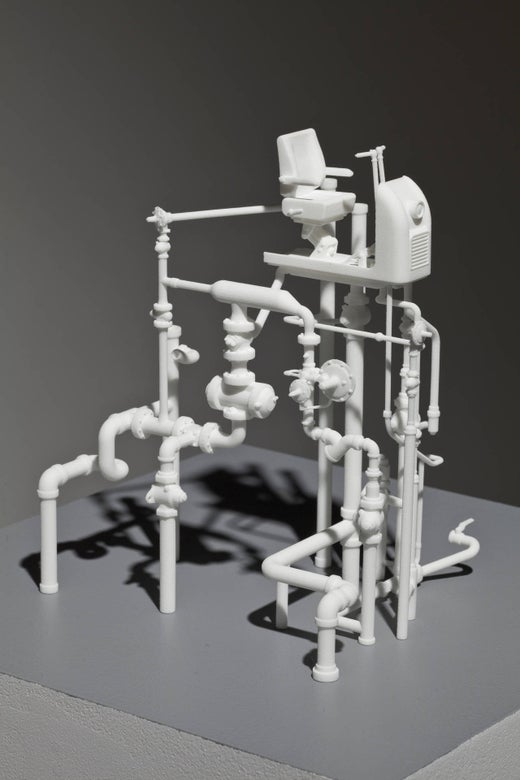Want more images or videos?
Request additional images or videos from the seller
1 of 5
Guillaume LachapelleLa déconvenue2010
2010
About the Item
Text by Marsha Taichman
[...] There is art
unless there is so much missing
we cannot build a structure around it..
- Kate Hall, from Water Tower, 1998-2000 (after Rachel Whiteread)
Montreal artist Guillaume Lachapelle presents a new collection of works at Art Mûr that is sure to surprise and delight gallery goers. These works are full of pristine lines and beautiful intrigue. He constructs and presents miniatures and life-size pieces that are subversive and unusual upon close examination. In these pieces, scale can be quite skewed. Even when objects are the size that we expect them to be, say, a 15-foot silver gazebo that one may enter and stand inside, they seem small. Lachapelle’s works can be mounted displays of tiny mechanical-seeming devices, apparatuses of unknown origins with no clear purpose, despite the fact that they offer a distinct air of functionality.
In the works that Lachapelle has selected for this exhibition at Art Mûr, his subject matter has moved away from human and animal scenes and delved deeper into free-standing machinations. This means that we will see a greater starkness and a closer focus on the materiality in his constructions. The collection is full of the unexpected and the unusual. A library with a sunken-in, curved interior of wavy shelves of books perches above a fire escape that leads to nowhere, implying that, in the event of a disaster, one will only be faced with another disaster as an alternative. A box structure is filled with the interior of a vehicle, complete with a steering wheel and pedals, with no exterior to situate what kind of vehicle it is, or suggestion of who would be its operator. This box seems to be carved from stone, but is actually made of a mottled grey plastic. An austere balcony is buttressed by a series of pipes, each one rendered impotent by the balcony itself. Rather than being utilitarian, we must instead appreciate the delicate filigree of the balcony’s fence and guardrail, and the intricate tangle of pipes. Lachapelle’s sculptures triumph form over function, every part seems to have a purpose.
What particularly appeals to me about Lachapelle’s art is how it seems to gesture to other artworks as well as the everyday without being derivative. He is skilled at coupling incongruous things.His sculptures channel the nostalgia of Joseph Cornell’s shadow boxes, Matthew Barney’s white plastic frames from the Cremaster cycle, the presence and absence of Rachel Whiteread’s castings of space, and Melvin Charney’s Colonnes allégoriques, a chorus of small buildings on pedestals in the sculpture garden of the Canadian Centre for Architecture. In these same pieces, there are echoes of common constructions like the frameworks of houses, kitchen sinks, and the mechanics of small, complex machines, suggesting both the commonplace and the magical.
- Creator:Guillaume Lachapelle (1974, Canadian)
- Creation Year:2010
- Dimensions:Height: 10 in (25.4 cm)Width: 6 in (15.24 cm)Depth: 6 in (15.24 cm)
- Medium:
- Movement & Style:
- Period:
- Condition:
- Gallery Location:Montreal, CA
- Reference Number:1stDibs: LU476667722
Guillaume Lachapelle
Guillaume Lachapelle’s artistic practice is shaped predominantly by sculpture, expressed in the form of installations and detailed miniature models. Lachapelle presents playful universes which combine objects of undetermined purpose; in this way, he opens the conventions of our reality to fresh disposition. The architecture of his models – which Lachapelle has recently begun to make with the help of the latest 3-D printing technology – shows motifs originating from the everyday, certainly, but seeming strange, alienating or even uncanny when combined as the artist chooses. A kind of transition between two worlds often appears in Lachapelle’s work – for example when the model of a library filled with books curves inwards and reveals a mysterious opening pointing into darkness – these are the artist’s references to spaces and occurrences which may be concealed below the surface of outward semblance. Guillaume Lachapelle has participated in several solo and group exhibitions including Manèges at Circa – Centre d’Exposition Art Contemporain (Montreal) in 2006; Quebec Gold at the Ancien Collège des Jésuites (Rheims, France) in 2008 and in Abracadabra (Edward Day Gallery, Toronto) in 2008. Recently, he completed a permanent commemorative sculpture in Belmont Park (the site of an amusement park that operated between 1923 and 1983) located in the Ahuntsic-Cartierville neighbourhood of Montreal.
About the Seller
5.0
Vetted Seller
These experienced sellers undergo a comprehensive evaluation by our team of in-house experts.
Established in 1996
1stDibs seller since 2014
96 sales on 1stDibs
- ShippingRetrieving quote...Ships From: Montreal, Canada
- Return PolicyA return for this item may be initiated within 7 days of delivery.
More From This SellerView All
- Night ShiftBy Guillaume LachapelleLocated in Montreal, QuebecText by Terence Sharpe There is a moment in Andrei Tarkovsky’s Solaris (1972) when the character Hari commits suicide by drinking liquid oxygen. As she is not actually a human, but an artificial hybrid product of the mysterious planet and the protagonists’ memories, she heals rapidly and is alive again minutes later. Her choice to take her own life is poignant, seemingly the action of a being becoming aware of its hopeless infinitude. Her realization that while the men will die on the space station or elsewhere, her existence is that of immortality, a deeply alienating notion that causes her to seek her own destruction. The Montreal artist Guillaume Lachapelle has one work that prompts a sense of eternal alienation that echoes Hari’s tragedy. The work greets the viewer with a empty doorway flanked by clinically white bookshelves...Category
2010s Contemporary Figurative Sculptures
MaterialsNylon, Glass, Wood, LED Light, Acrylic
- UntitledBy Guillaume LachapelleLocated in Montreal, QuebecText by Terence Sharpe There is a moment in Andrei Tarkovsky’s Solaris (1972) when the character Hari commits suicide by drinking liquid oxygen. As she is not actually a human, but an artificial hybrid product of the mysterious planet and the protagonists’ memories, she heals rapidly and is alive again minutes later. Her choice to take her own life is poignant, seemingly the action of a being becoming aware of its hopeless infinitude. Her realization that while the men will die on the space station or elsewhere, her existence is that of immortality, a deeply alienating notion that causes her to seek her own destruction. The Montreal artist Guillaume Lachapelle has one work that prompts a sense of eternal alienation that echoes Hari’s tragedy. The work greets the viewer with a empty doorway flanked by clinically white bookshelves...Category
2010s Contemporary Figurative Sculptures
MaterialsNylon, Glass, Wood, LED Light
- Night shift IIBy Guillaume LachapelleLocated in Montreal, QuebecText by Terence Sharpe There is a moment in Andrei Tarkovsky’s Solaris (1972) when the character Hari commits suicide by drinking liquid oxygen. As she is not actually a human, but an artificial hybrid product of the mysterious planet and the protagonists’ memories, she heals rapidly and is alive again minutes later. Her choice to take her own life is poignant, seemingly the action of a being becoming aware of its hopeless infinitude. Her realization that while the men will die on the space station or elsewhere, her existence is that of immortality, a deeply alienating notion that causes her to seek her own destruction. The Montreal artist Guillaume Lachapelle has one work that prompts a sense of eternal alienation that echoes Hari’s tragedy. The work greets the viewer with a empty doorway flanked by clinically white bookshelves...Category
2010s Contemporary Figurative Sculptures
MaterialsNylon, Glass, LED Light, Acrylic
- FetchLocated in Montreal, QuebecIn his recent works sculptor Nicholas Crombach uses the markers of tradition to critique social rituals. Through the employment of the mythology and the rich visual culture of the hunt, Crombach assembles works which revel in contradiction. He has created a series of unexpected juxtapositions that examine the cultural significance and the complex issues percolating around hunting and sporting traditions in the 21st century. For this exhibition, Crombach riffs off the myth of Diana and Actaeon, which provides a poignant framework for his theme. In the original story, Actaeon, the hunter and grandson of King Cadmus, is in the forest with his dogs, when he spies Artemis (Diana) in her bath attended by her nymphs. Diana was the goddess of the hunt, but when the mortal Actaeon sees her, her nymphs try to cover her modesty. She splashes him with water, turning him from a mortal man into a stag, who flees into the forest only to be hunted down and killed by his own dogs. The hunter becomes the hunted. Crombach’s Fetch (2018) refers to the mythology of Diana and Actaeon as he transforms the lofty and classical story of metamorphoses into a game of fetch in the local park, constructed on a grand scale. In Fetch (2018), Crombach creates a hybrid between the art historical imagery from paintings of hounds hunting stags with the flashy colours and synthetic materials of modern day dog chew toys. The sculpture is displayed alongside a variety of chew toys that act as an index for the sculptures interpretation, some transformed into porcelain that has been marked with the aristocratic hunting motifs found on antique English pottery. Here, the assembly of works create a conversation on the blurred boundaries between: histories of domestication, the working relationships we have with animals, contemporary issues of hunting as “play”, tradition and survival. A second major new sculpture “End of the Chase” is a collapsed version of a Victorian period rocking horse housed in London’s V&A Museum Of Childhood. The sculpture responds to the 2014 hunting act that passed in Britain which in turn attempts to obliterate the tradition of hunting with hounds, most commonly associated with the fox hunt...Category
2010s Contemporary Figurative Sculptures
MaterialsAcrylic, Polyurethane, Nylon, Resin
- Nuit étoiléeBy Guillaume LachapelleLocated in Montreal, QuebecGuillaume Lachapelle's artistic practice is shaped predominantly by sculpture, expressed in the form of installations and detailed miniature models. Lachapelle presents playful unive...Category
21st Century and Contemporary Contemporary Sculptures
MaterialsNylon, Glass, LED Light
- CentaureBy Guillaume LachapelleLocated in Montreal, QuebecGuillaume Lachapelle’s artistic practice is shaped predominantly by sculpture, expressed in the form of installations and detailed miniature models. Lachapelle presents playful unive...Category
2010s Contemporary Figurative Sculptures
MaterialsNylon
You May Also Like
- BreathLocated in New Orleans, LAThierry Job was born in Marseille, France and currently lives in San Miguel de Allende, Mexico. He studied art at the School of Beaux Arts in Paris. His works as been exhibited at th...Category
2010s Contemporary Figurative Sculptures
MaterialsSteel
- Fiber Sculpture: 'IMAGINATION'By Federica Patera and Andrea Sbra PeregLocated in New York, NYImage, Imagination, Imitation: we can think these three words come from the roots √Im, but it’s not true. It’s necessary to combine the proposition in with mi, that is, √Mei, to obtain this kind of words. √Mei recalls something that catch the attention, that is intermittent and that can change. For the three following artworks we decided to decline the root starting from the concepts of light and sound, using a set of different languages, such as English, Russian, Sanskrit, Latin, Avestan, Greek and Persian, and to create shapes...Category
2010s Contemporary Figurative Sculptures
MaterialsSteel, Wire
- Fiber Wall Sculpture: 'IMAGE'By Federica Patera and Andrea Sbra PeregLocated in New York, NYImage, Imagination, Imitation: we can think these three words come from the roots √Im, but it’s not true. It’s necessary to combine the proposition in with mi, that is, √Mei, to obta...Category
2010s Contemporary Figurative Sculptures
MaterialsWire, Steel
- MIRROR - Contemporary - Geometric Abstract w/ Repurposed Construction MaterialLocated in Signal Mountain, TN"Mirror" is a site specific installation that was exhibited in the show "Dialects of Place(s) by Land Report Collective at COOP Gallery in Nashville, TN. In this piece, Jobe uses industrial materials such as insulation foam, concrete, window screen, and graphite tracing paper to create a patterned structure that protrudes from the corner and carries the viewer's eye upward. At the bottom of the piece, we see delicately balanced concrete on top of pale blue insulation foam. The patterned concrete and insulation foam carries the viewer's eye upwards towards another pop of blue on top of the aluminum window screen frame. The screen gives the viewer a window in which to look through the piece. On one side, this mesh frames the graphite paper and on the other side the viewer can see the patterned concrete and insulation foam. Review from "The Rib" about "Mirror" One of the more surprising works here is Nashville-based Brian Jobe...Category
2010s Contemporary Abstract Sculptures
MaterialsConcrete
- Sinuosity petite in lavender (curvy, sculpture, biomorphic, pastel art)By Ted VanCleaveLocated in Quebec, Quebeckeywords; #sinuous, focus on material, sculptural folds, Aldo Chaparro, use of common materials, creased crinkled and wrinkled, angular, abstract sculpture, angular, process-oriented, mixed-media, sparse, biomorphic, abstract sculpture, contemporary design, sculpture, line form color, curvilinear forms, balance, smooth surfaces, contemporary minimalism, pop art, metallic surfaces, textile art, yellow, shiny, luxurious, curvy, pop art, kitsch, lavender art...Category
2010s Contemporary Abstract Sculptures
MaterialsConcrete
- Sinuosity mini in bubblegum (pink, pastel, soft, curvy, small sculpture, smooth)By Ted VanCleaveLocated in Quebec, Quebec*Please inquire for commissions of any other size, color or surface rendering keywords; #sinuous, focus on material, sculptural folds, Aldo Chaparro, use of common materials, creased...Category
2010s Contemporary Abstract Sculptures
MaterialsConcrete
Recently Viewed
View AllMore Ways To Browse
Kitchen Sculptures
Garden Water Sculptures
Mechanical Sculpture
Small Art Pedestal
Life Size Garden Sculpture
White Pedestal Art
Sculpture Grey Stone
Pedestals La
White Pedestal With Sculpture
Sculpture Building Gray Stone
Stone Pedestal For Sculpture
Used Kitchen Sinks
Fire Escape Used
Steering Wheel
Stone Pedestal Stand
Plastic Library
Tangle Sculpture
Pedestal Sink Used

